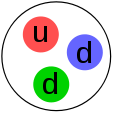Neutron flux
| Science with neutrons |
|---|
 |
| Foundations |
| Neutron scattering |
| Other applications |
|
| Infrastructure |
|
| Neutron facilities |
The neutron flux is a scalar quantity used in nuclear physics and nuclear reactor physics. It is the total length travelled by all free neutrons per unit time and volume.[1] Equivalently, it can be defined as the number of neutrons travelling through a small sphere of radius in a time interval, divided by (the cross section of the sphere) and by the time interval.[2] The usual unit is cm−2s−1 (Neutrons per centimeter squared per second).
The neutron fluence is defined as the neutron flux integrated over a certain time period, so its usual unit is cm−2 (neutrons per centimeter squared).
Natural neutron flux
Neutron flux in asymptotic giant branch stars and in supernovae is responsible for most of the natural nucleosynthesis producing elements heavier than iron. In stars there is a relatively low neutron flux on the order of 105 to 1011 cm−2 s−1, resulting in nucleosynthesis by the s-process (slow-neutron-capture-process). By contrast, after a core-collapse supernova, there is an extremely high neutron flux, on the order of 1022 cm−2 s−1, resulting in nucleosynthesis by the r-process (rapid-neutron-capture-process).
Atmospheric neutron flux, apparently from thunderstorms, can reach levels of 3·10−2 to 9·10+1 cm−2 s−1.[3][4] However, recent results[5] (considered invalid by the original investigators[6]) obtained with unshielded scintillation neutron detectors show a decrease in the neutron flux during thunderstorms. Recent research appears to support lightning generating 1013 - 1015 neutrons per discharge via photonuclear processes.[7]
Artificial neutron flux
Artificial neutron flux refers to neutron flux which is man-made, either as byproducts from weapons or nuclear energy production or for a specific application such as from a research reactor or by spallation. A flow of neutrons is often used to initiate the fission of unstable large nuclei. The additional neutron(s) may cause the nucleus to become unstable, causing it to decay (split) to form more stable products. This effect is essential in fission reactors and nuclear weapons.
Within a nuclear fission reactor, the neutron flux is the primary quantity measured to control the reaction inside. The flux shape is the term applied to the density or relative strength of the flux as it moves around the reactor. Typically the strongest neutron flux occurs in the middle of the reactor core, becoming lower toward the edges. The higher the neutron flux the greater the chance of a nuclear reaction occurring as there are more neutrons going through an area per unit time.
Reactor vessel wall neutron fluence
A reactor vessel of a typical nuclear power plant (PWR) endures in 40 years (32 full reactor years) of operation approximately 3.5×1019 cm−2 (E > 1 MeV).[8] Neutron flux causes reactor vessels to suffer from Neutron embrittlement and the steel gets activated.
See also
References
- ↑ Rudi J. J. Stamm'ler, Máximo Julio Abbate, Methods of steady-state reactor physics in nuclear design. ISBN 978-0126633207
- ↑ K. H. Beckurts, K. Wirtz: Neutron Physics. Springer 1964, ISBN 978-3-642-87616-5, pages 82-83
- ↑ Gurevich, A. V.; Antonova, V. P. (2012). "Strong Flux of Low-Energy Neutrons Produced by Thunderstorms". Physical Review Letters. Americal Physical Society. 108 (12): 125001. Bibcode:2012PhRvL.108l5001G. doi:10.1103/PhysRevLett.108.125001. PMID 22540588.
- ↑ Gurevich, A. V.; Almenova, A. M. (2016). "Observations of high-energy radiation during thunderstorms at Tien-Shan". Physical Review D. Americal Physical Society. 94 (2): 023003. Bibcode:2016PhRvD..94b3003G. doi:10.1103/PhysRevD.94.023003.
- ↑ Alekseenko, V.; Arneodo, F.; Bruno, G.; Di Giovanni, A.; Fulgion, W.; Gromushkin, D.; Shchegolev, O.; Stenkin, Yu.; Stepanov, V.; Sulakov, V.; Yashin, I. (2015). "Decrease of Atmospheric Neutron Counts Observed during Thunderstorms". Physical Review Letters. Americal Physical Society. 114 (12). Bibcode:2015PhRvL.114l5003A. doi:10.1103/PhysRevLett.114.125003.
- ↑ Gurevich, A. V.; Ptitsyn, M. O. (2015). "Comment on "Decrease of Atmospheric Neutron Counts Observed during Thunderstorms"". Physical Review Letters. Americal Physical Society. 115 (12): 179501. Bibcode:2015PhRvL.115q9501G. doi:10.1103/PhysRevLett.115.179501.
- ↑ Köhn, Christoph; Diniz, Gabriel; Harakeh, GMushin (2017). "Production mechanisms of leptons, photons, and hadrons and their possible feedback close to lightning leaders". Journal of Geophysical Research: Atmospheres. Americal Geophysical Union. 122 (2): 1366. Bibcode:2017JGRD..122.1365K. doi:10.1002/2016JD025445.
- ↑ Nuclear Power Plant Borssele Reactor Pressure Vessel Safety Assessment, p. 29, 5.6 Neutron Fluence Calculation.